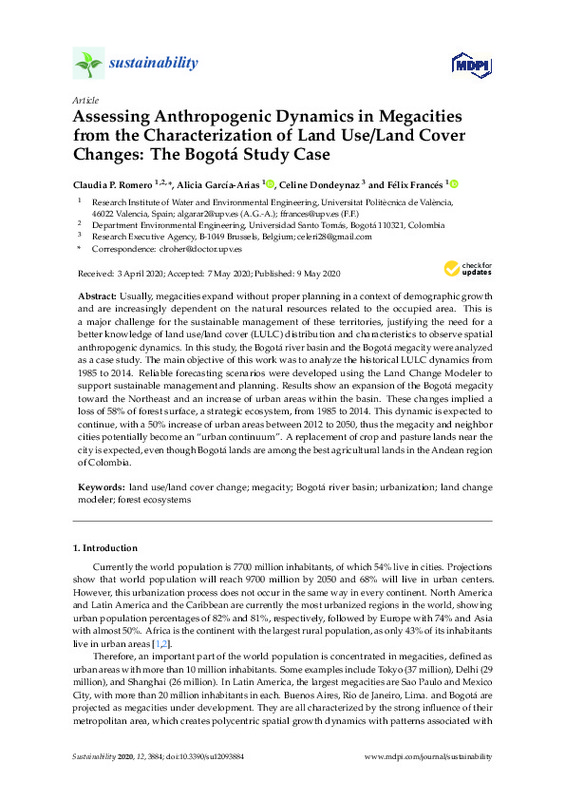Olaya Marín, EJ.; Martinez-Capel, F.; Soares Costa, RM.; Alcaraz-Hernández, JD. (2012). Modelling native fish richness to evaluate the effects of hydromorphological changes and river restoration (Júcar River Basin, Spain). Science of the Total Environment. 440:95-105. doi:10.1016/j.scitotenv.2012.07.093
Por favor, use este identificador para citar o enlazar este ítem: http://hdl.handle.net/10251/33328
|
Título:
|
Modelling native fish richness to evaluate the effects of hydromorphological changes and river restoration (Júcar River Basin, Spain)
|
|
Autor:
|
Olaya Marín, Esther Julia

 Martinez-Capel, Francisco
Soares Costa, Rui Manuel
Alcaraz-Hernández, Juan Diego
Martinez-Capel, Francisco
Soares Costa, Rui Manuel
Alcaraz-Hernández, Juan Diego
|
|
Entidad UPV:
|
Universitat Politècnica de València. Instituto de Investigación para la Gestión Integral de Zonas Costeras - Institut d'Investigació per a la Gestió Integral de Zones Costaneres
Universitat Politècnica de València. Departamento de Ingeniería Hidráulica y Medio Ambiente - Departament d'Enginyeria Hidràulica i Medi Ambient
|
|
Fecha difusión:
|
|
|
Resumen:
|
The richness of native fish is considered to be an indicator of aquatic ecosystem health, and improving richness is a key goal in the management of river ecosystems. An artificial neural network (ANN) model based on field ...[+]
The richness of native fish is considered to be an indicator of aquatic ecosystem health, and improving richness is a key goal in the management of river ecosystems. An artificial neural network (ANN) model based on field data from 90 sample sites distributed throughout the Júcar River Basin District was developed to predict the native fish species richness (NFSR). The Levenberg-Marquardt learning algorithm was used for model training. When constructing the model, we tried different numbers of neurons (hidden layers), compared different transfer functions, and tried different k values (from 3 to 10) in the k-fold cross-validation method. This process and the final selection of key variables with relevant ecological meaning support the reliability and robustness of the final ANN model. The partial derivatives method was applied to determine the relative importance of input environmental variables. The final ANN model combined variables describing riparian quality, water quality, and physical habitat and helped identify the primary drivers of the NFSR patterns in Mediterranean rivers. In the second part of the study, the model was used to evaluate the effectiveness of two restoration actions in the Júcar River: the removal of two abandoned weirs and the progressive increase in the proportion of riffles. The model indicated that the combination of these actions produced a rise in NFSR, which ultimately reached the maximum values observed in the reference site of that river ecotype (sensu the European Water Framework Directive). The results demonstrate the importance of longitudinal connectivity and riffle proportion for improving NFSR and the power of ANNs to help decisions in the management and ecological restoration of Mediterranean rivers. Furthermore, this model at the basin scale is the first step for further research on the effects of water scarcity and global change on Mediterranean fish communities.
[-]
|
|
Palabras clave:
|
Artificial neural networks
,
Fish richness
,
Hydromorphology
,
Mitigation measures
,
River connectivity
,
River restoration
,
Aquatic ecosystem
,
Artificial neural network models
,
Basin scale
,
Cross-validation methods
,
Ecological restoration
,
Environmental variables
,
European Water Framework Directive
,
Field data
,
Fish communities
,
Fish species richness
,
Global change
,
Hidden layers
,
K-values
,
Key variables
,
Levenberg-Marquardt learning algorithms
,
Mediterranean rivers
,
Model training
,
Partial derivatives
,
Physical habitat
,
Reference sites
,
Reliability and robustness
,
River basins
,
River ecosystem
,
Water scarcity
,
Ecosystems
,
Fish
,
Learning algorithms
,
Neural networks
,
Restoration
,
Water quality
,
Watersheds
,
Rivers
,
Artificial neural network
,
Bioindicator
,
Ecomorphology
,
Ecosystem health
,
Ecosystem management
,
Habitat quality
,
Mitigation
,
Model validation
,
Restoration ecology
,
Riffle
,
River basin
,
River management
,
Species richness
,
Article
,
Ecosystem restoration
,
Environmental change
,
Environmental factor
,
Environmental impact assessment
,
Learning algorithm
,
Mathematical model
,
Nonhuman
,
Priority journal
,
Riparian ecosystem
,
Sensitivity analysis
,
Validation process
,
Jucar Basin
,
Spain
|
|
Derechos de uso:
|
Cerrado |
|
Fuente:
|
Science of the Total Environment. (issn:
0048-9697
)
|
|
DOI:
|
10.1016/j.scitotenv.2012.07.093
|
|
Editorial:
|
Elsevier
|
|
Versión del editor:
|
http://dx.doi.org/10.1016/j.scitotenv.2012.07.093
|
|
Código del Proyecto:
|
info:eu-repo/grantAgreement/MEC//CGL2007-66412/ES/EVALUACION DEL POTENCIAL ECOLOGICO DE RIOS REGULADOS POR EMBALSES Y DESARROLLO DE CRITERIOS PARA SU MEJORA SEGUN LA DIRECTIVA MARCO DEL AGUA./ /
info:eu-repo/grantAgreement/MICINN//CSD2009-00065/ES/Evaluación y predicción de los efectos del cambio global en la cantidad y la calidad del agua en ríos ibéricos/
|
|
Agradecimientos:
|
This study was partially funded by the Spanish Ministry of Economy and Competitiveness with the projects SCARCE (Consolider-Ingenio 2010 CSD2009-00065) and POTECOL "Evaluacion del Potencial Ecologico de Rios Regulados por ...[+]
This study was partially funded by the Spanish Ministry of Economy and Competitiveness with the projects SCARCE (Consolider-Ingenio 2010 CSD2009-00065) and POTECOL "Evaluacion del Potencial Ecologico de Rios Regulados por Embalses y Desarrollo de Criterios para su mejora segun la Directiva Marco del Agua" (CGL2007-66412). We thank to Confederacion Hidrografica del Jucar (Spanish Ministry of Agriculture, Food and Environment) for the data provided to develop this study. We thank Sasa Plestenjak in the collaboration for building the first fish database elaborated in this research.
[-]
|
|
Tipo:
|
Artículo
|






![[Cerrado]](/themes/UPV/images/candado.png)




